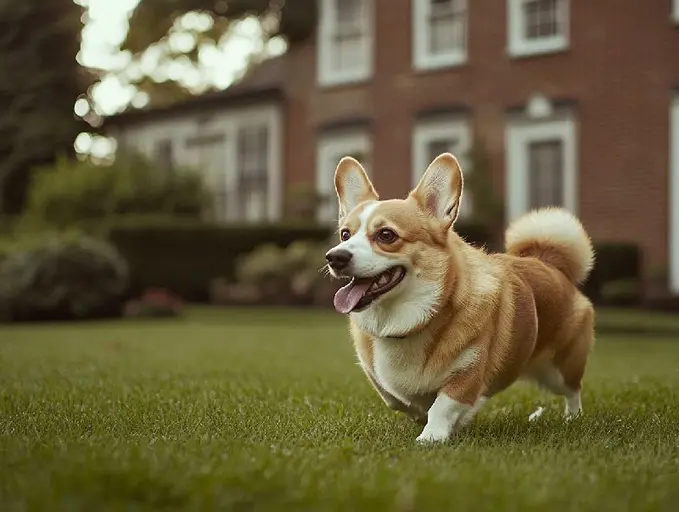Pembroke Welsh Corgi: The Ultimate Breed Guide

Brief Introduction
The Pembroke Welsh Corgi! This low-riding, big-eared breed has captured hearts worldwide with their charming looks and spirited personalities. Instantly recognizable by their short legs, long body, and fox-like face, Corgis are more than just a pretty face. They’re intelligent, affectionate, and surprisingly athletic. Their playful expression and devoted nature make them wonderful companions for the right owner. While often associated with royalty, particularly Queen Elizabeth II, who had a lifelong love for them, the Pembroke Welsh Corgi is a working breed at heart, retaining the herding instincts of their ancestors. They are family-friendly, and love being involved in all activities.
Breed History
Origins and Purpose
The Pembroke Welsh Corgi’s history is steeped in mystery and folklore. It is believed that the breed originated in Pembrokeshire, Wales, dating back as far as 1107 AD. There are several theories about their ancestry. Some believe they descended from Swedish Vallhunds, brought to Wales by Vikings. Others suggest they are related to Spitz-type dogs. Regardless of their precise origins, the Corgi was initially used as a herding dog, specifically for cattle, sheep, and even geese.
Herding Heritage
Their short stature was not a disadvantage on the farm. It allowed them to nip at the heels of livestock without being kicked, effectively driving them without harm. Their agility and intelligence made them adept at maneuvering through the herd. The Corgi’s job wasn’t just herding; they also served as watchdogs, alerting farmers to approaching strangers and predators.
Breed Development and Recognition
Over time, the Pembroke Welsh Corgi and the Cardigan Welsh Corgi were often interbred, leading to some confusion about their separate identities. It wasn’t until the early 20th century that efforts were made to distinguish the two breeds. The UK Kennel Club officially recognized the Pembroke Welsh Corgi as a separate breed in 1934. They quickly gained popularity, boosted by Queen Elizabeth II’s well-documented love of the breed. Now, the Pembroke Welsh Corgi is known and loved around the world, not only as a working dog, but as excellent companion dogs.
Appearance
Size and Build
Pembroke Welsh Corgis are small but sturdy dogs. They typically stand 10 to 12 inches tall at the shoulder. Males generally weigh between 25 and 30 pounds, while females are slightly lighter, weighing between 22 and 28 pounds. Their long body and short legs give them a distinctive appearance. They are muscular and agile, reflecting their working dog heritage.
Coat and Color
The Pembroke Welsh Corgi has a double coat, consisting of a dense, short undercoat and a longer, coarser outer coat. This double coat provides insulation against both heat and cold. The standard color variations include:
- Red
- Sable
- Fawn
- Black and Tan
These colors can be found with or without white markings, often on the chest, neck, legs, and face.
Head and Facial Features
Corgis have a fox-like face with a slightly pointed muzzle and alert expression. Their ears are erect and proportionally large for their head, giving them a characteristic ‘bat-eared’ appearance. Their eyes are oval-shaped and typically dark brown, conveying intelligence and warmth.
Tail
Historically, Pembroke Welsh Corgis were often docked (having a portion of their tail removed). However, tail docking is now banned or restricted in many countries. Some Corgis are born with naturally bobbed tails, while others have full-length tails that curve slightly over their back. Even with a tail, the Corgi’s characteristic build remains unmistakable.

Character and Behavior
Temperament and Personality
Pembroke Welsh Corgis are known for their intelligent, playful, and affectionate nature. They are generally outgoing and friendly, making them good family pets. They are eager to please and enjoy being part of the action, whether it’s playing with children in the backyard or relaxing on the couch with their owners.
Attitude Towards People and Children
Corgis are typically good with children, though it’s important to supervise interactions, especially with younger children. Their herding instincts may sometimes lead them to nip at heels, a behavior that needs to be addressed with training. Early socialization can help them develop positive relationships with people of all ages.
Interaction with Other Animals
With proper socialization, Corgis can get along well with other dogs and even cats. However, their herding instincts can surface with smaller animals, such as rodents or birds. Introduced properly at a young age, Corgis and other animals can live together peacefully.
Activity Level and Exercise Needs
Despite their short legs, Corgis are surprisingly energetic dogs. They require regular exercise to stay physically and mentally stimulated. Daily walks, playtime in the backyard, and interactive games like fetch are all good ways to keep them happy and healthy. They also excel in dog sports such as herding trials, agility, and obedience.
Trainability
Corgis are highly intelligent and generally easy to train. They respond well to positive reinforcement methods, such as treats and praise. Consistency and patience are key to successful training. They can be trained for almost anything, from basic commands to complex tricks. Enrolling in obedience classes or working with a professional dog trainer can be beneficial, especially for first-time Corgi owners.
Care and Maintenance
Grooming Needs
Corgis have a double coat that requires regular grooming. They shed moderately year-round, with heavier shedding periods during the spring and fall. Brushing them several times a week with a slicker brush or undercoat rake can help remove loose hair and prevent matting. They only need to be bathed as needed, usually every few months, unless they get particularly dirty.
Exercise Requirements
Corgis need regular exercise, but their short legs mean they are not built for excessive running or jumping. Daily walks of 30-60 minutes will keep them physically challenged. Incorporating games like fetch or tug-of-war into their routine can also help them burn energy. Make sure to choose exercises that are appropriate for their physical limitations.
Feeding and Diet
It’s important to feed Corgis a high-quality dog food that is appropriate for their age, size, and activity level. Because they are prone to weight gain, it’s crucial to monitor their food intake and avoid overfeeding. Consult with a veterinarian to determine the right portion sizes and to choose a food that meets their specific nutritional needs.
Health Concerns
While Corgis are generally healthy dogs, they are prone to certain health problems, including:
- Hip dysplasia
- Progressive retinal atrophy (PRA)
- Intervertebral disc disease (IVDD). Their long backs make them prone to this.
- Von Willebrand’s disease
Regular veterinary checkups and genetic testing can help identify these conditions early and allow for timely treatment. Maintaining a healthy weight and providing regular exercise can also help prevent or manage some of these health issues.
Breed Weaknesses
Potential for Aggression
While Corgis are generally friendly, some individuals may exhibit aggression towards strangers, other dogs, or even children. This can be more common in Corgis who have not been properly socialized and trained. Puppy socialization classes can help to prevent and manage aggression. Consistency and patience during training will make a difference.
Loyalty and Independence
Corgis are very loyal to their families and will usually bond closely with one or two people in the household. While they are eager to please, they can also be somewhat independent and headstrong. This can make training a bit more challenging, but with the right methods and approach, they can be successful in learning many things.
Specific Weaknesses
Because of their body shape, Corgis have a tendency to gain weight easily, which can put them at risk for health problems. They also have a higher risk of IVDD and other back issues due to their long spines. Their herding instincts can also be a challenge for some owners, as they may try to herd children or other pets. Early training and socialization also help to prevent nipping at heels.
Conclusion
The Pembroke Welsh Corgi is a charming and intelligent breed that can make a wonderful companion for the right owner. They are best suited for active families who are willing to provide them with plenty of exercise, mental stimulation, and training. They thrive on human interaction and love being involved in family activities. Although they have some weaknesses, with the right care and attention, Corgis can live long, healthy, and happy lives. If you’re prepared to meet their needs, you’ll be rewarded with a loyal, affectionate, and entertaining companion.
Frequently Asked Questions About Pembroke Welsh Corgi
-
What is a Pembroke Welsh Corgi?
The Pembroke Welsh Corgi is a small, low-riding herding breed known for its short legs, long body, and fox-like face. They are intelligent, affectionate, and make excellent companions.
-
What is the average size and weight of a Corgi?
Pembroke Welsh Corgis typically stand 10 to 12 inches tall at the shoulder. Males weigh between 25 and 30 pounds, while females weigh between 22 and 28 pounds.
-
What kind of temperament do Corgis have?
Corgis are known for their intelligent, playful, and affectionate nature. They are generally outgoing and friendly, making them good family pets. They are eager to please and enjoy being part of the action.
-
Are Corgis good with children?
Corgis are typically good with children, though it’s important to supervise interactions, especially with younger children. Their herding instincts may sometimes lead them to nip at heels, a behavior that needs to be addressed with training.
-
How much exercise do Corgis need?
Despite their short legs, Corgis are surprisingly energetic dogs. They require regular exercise to stay physically and mentally stimulated. Daily walks of 30-60 minutes and interactive games are beneficial.
-
Are Corgis easy to train?
Corgis are highly intelligent and generally easy to train. They respond well to positive reinforcement methods, such as treats and praise. Consistency and patience are key to successful training.
-
What are the grooming needs for a Corgi?
Corgis have a double coat that requires regular grooming. They shed moderately year-round, with heavier shedding periods during the spring and fall. Brushing them several times a week can help remove loose hair.
-
What are some common health concerns for Corgis?
While Corgis are generally healthy dogs, they are prone to certain health problems, including hip dysplasia, progressive retinal atrophy (PRA), and intervertebral disc disease (IVDD).
-
Do Corgis have any specific weaknesses?
Because of their body shape, Corgis have a tendency to gain weight easily. They also have a higher risk of IVDD and other back issues due to their long spines. Their herding instincts can also be a challenge for some owners.
-
Are Corgis good for first-time dog owners?
Corgis can be good for first-time dog owners who are willing to dedicate time and effort to training and socialization. Enrolling in obedience classes or working with a professional dog trainer can be beneficial.

